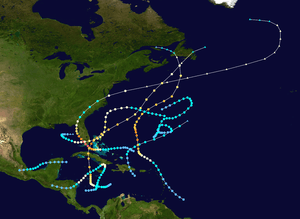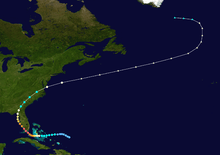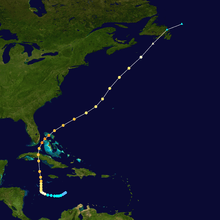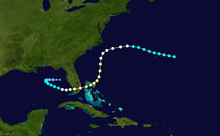1935 Atlantic hurricane season
| |
| Season summary map |
| First system formed |
May 15, 1935 |
| Last system dissipated |
November 14, 1935 |
| Strongest storm |
"Labor Day"/Three – 892 mbar (hPa) (26.35 inHg), 185 mph (295 km/h) (1-minute sustained) |
| Total storms |
8 |
| Hurricanes |
5 |
| Major hurricanes (Cat. 3+) |
3 |
| Total fatalities |
2604 total |
| Total damage |
> $12.5 million (1935 USD) |
Atlantic hurricane seasons
1933, 1934, 1935, 1936, 1937 |
The 1935 Atlantic hurricane season ran from June 16 through October 31, 1935. The 1935 season featured below average activity, but it was eventful. A Category 1 hurricane in the Caribbean killed an estimated 2,150 people in the Greater Antilles and Central America. A Category 3 storm hit central Cuba and grazed Miami. An extratropical hurricane hit Newfoundland. The third tropical cyclone of the season struck the Florida Keys in southern Florida as a Category 5 hurricane; it remains the strongest landfalling hurricane in the United States (and anywhere in the Atlantic basin).[1] A rare November hurricane also affected the Miami—Fort Lauderdale area.
Storms
Tropical Storm One
| Tropical storm (SSHWS) |
|
|
| Duration |
May 15 – May 18 |
| Peak intensity |
60 mph (95 km/h) (1-min) 1003 mbar (hPa) |
A tropical depression developed in the northeastern Caribbean Sea on May 15. It soon struck Dominican Republic and moved northward across the island. After emerging into the Atlantic Ocean, the depression strengthened into a tropical storm on May 16. The storm then accelerated northeastward and became extratropical. on May 18, while located east-southeast of Bermuda.[2]
Hurricane Two
| Category 4 hurricane (SSHWS) |
|
|
| Duration |
August 16 – August 25 |
| Peak intensity |
135 mph (215 km/h) (1-min) 955 mbar (hPa) |
A hurricane was detected near the Leeward Islands on August 18. Moving west-northwest, the storm gradually intensified into a Category 2 hurricane the following day. On August 20, the system began to curve northward and later north-northeast, and the hurricane reached its peak of 135 miles per hour (217 km/h) on August 22. The hurricane later passed just west of Bermuda late on August 22 as a slightly weaker 115 miles per hour (185 km/h) hurricane. On August 24, the hurricane weakened to a Category 2 hurricane and began to turn more to the north. Continuing to curve northwestward on August 25, the hurricane continued to weaken to a Category 1 hurricane, later striking Newfoundland as an extratropical storm on August 26, doing noticeable damage. The storm later dissipated on the same day.
Hurricane Three
| Category 5 hurricane (SSHWS) |
|
|
| Duration |
August 29 – September 6 |
| Peak intensity |
185 mph (295 km/h) (1-min) 892 mbar (hPa) |
By far the most notable storm of the season was the Labor Day Hurricane that made landfall in the Florida Keys on September 2. The storm was first detected as a disturbance east of the Bahamas. It strengthened very rapidly as it moved across the Straits of Florida. It made landfall on Craig Key in the Upper Keys as a small but intense Category 5 major hurricane. A pressure reading of 892 millibars (26.35 inHg) was recorded near where the center crossed the islands. The pressure reading makes the Labor Day Hurricane the most intense to ever strike the U.S. as well as in the entire Atlantic Basin. It ranks third on the list of the most intense Atlantic hurricanes based on lowest pressure, behind only Hurricane Gilbert of 1988 (888 mb), which did not strike the U.S., and Wilma of 2005 (882 mb).
After crossing the Keys, the storm proceeded up the Florida west coast, bringing flooding rains all along the way. The storm made its final landfall on the sparsely populated Apalachee coast near Cedar Key on September 5. It moved inland and then curved back out to sea and later dissipated in the North Atlantic on September 10. More than 400 people were killed in the Keys and the damage in the area of landfall was catastrophic. Portions of the Florida East Coast Railway in the Upper Keys were severely damaged or destroyed. The hurricane also washed an evacuation train off the tracks and many who were awaiting rescue, including World War I veterans who were living and working in the Keys as part of a government relief project, were killed.
Tropical Storm Four
| Tropical storm (SSHWS) |
|
|
| Duration |
August 30 – September 2 |
| Peak intensity |
60 mph (95 km/h) (1-min) 1001 mbar (hPa) |
A short-lived tropical storm formed west of the Yucatán Peninsula on August 31.[3] The tropical cyclone strengthened to its peak with winds of 60 miles per hour (97 km/h) over the Bay of Campeche.[3] The system eventually weakened to a depression on September 2 shortly after making landfall in mainland Mexico. The system weakened after moving inland and dissipated later on the same day.
Hurricane Five
| Category 4 hurricane (SSHWS) |
|
|
| Duration |
September 23 – October 2 |
| Peak intensity |
140 mph (220 km/h) (1-min) 945 mbar (hPa) |
A tropical storm formed in the western Caribbean Sea south-southeast of Jamaica on September 23. Moving westward, the system strengthened into a hurricane on September 24 and later a Category 2 hurricane on September 26 while beginning to curve northward. The hurricane continued to strengthen while slowly moving northward, strengthening to its peak of 120 miles per hour (190 km/h) as a major hurricane on September 28. The hurricane struck Cuba at its peak intensity shortly thereafter, and it maintained intensity while entering the Straits of Florida on September 29. While beginning to turn northeast, the hurricane passed over the Bahamas shortly thereafter as a 115 miles per hour (185 km/h) Category 3 hurricane, eventually weakening to a Category 2 hurricane on September 30 while accelerating away from the United States mainland. The hurricane passed near Bermuda on October 1, later weakening to a Category 1 hurricane and becoming extratropical the following day. The storm caused great destruction across Cuba and the Bahamas, killing 50 people (mostly in floods). Bimini was swamped by a 15-foot (4.6 m) storm surge that destroyed most of the buildings on the island, and winds were estimated near 120 miles per hour (190 km/h).[4]
Hurricane Six
| Category 1 hurricane (SSHWS) |
|
|
| Duration |
October 18 – October 27 |
| Peak intensity |
85 mph (140 km/h) (1-min) 988 mbar (hPa) |
A tropical storm formed late in the season on October 18 in the south-central Caribbean Sea with winds of 40 miles per hour (64 km/h).[3] Moving slowly north-northeast, the system strengthened quickly into a hurricane on October 20, and it attained its first peak intensity of 85 miles per hour (137 km/h) just south-southeast of Kingston.[3] The hurricane slowed on October 22 just east of Jamaica. Later, the hurricane made landfall near Santiago de Cuba early on October 23.[3] Continuing to turn southwest on October 23, the system weakened to a 60 miles per hour (97 km/h) tropical storm in the western Caribbean. The system began to reintensify shortly thereafter, regaining hurricane status late on October 24 and regaining a second peak intensity of 65 miles per hour (105 km/h) on October 25. On October 26, it made landfall in Honduras as a Category 1 hurricane.[3] The hurricane maintained intensity after moving inland before weakening to a tropical storm on October 26, eventually weakening to a tropical depression on October 27 over interior Central America. The system dissipated shortly thereafter. This storm caused catastrophic flooding that killed roughly 2,150 people in Haiti and Central America and caused upwards of $2 million in damages (1935 dollars).[4]
Hurricane Seven
| Category 2 hurricane (SSHWS) |
|
|
| Duration |
October 30 – November 8 |
| Peak intensity |
105 mph (165 km/h) (1-min) 964 mbar (hPa) |
A rare early November hurricane strike in the Miami area, this storm began as a tropical storm near Bermuda on October 30. Moving westward, the storm strengthened to a 75 miles per hour (121 km/h) Category 1 hurricane on November 1 while initially threatening the North Carolina coastline. The system began to turn southwest on November 2, however, while continuing to strengthen to its peak of 80 miles per hour (130 km/h), while a ship recorded a minimal pressure of 980 mbar. The hurricane continued moving slowly south-southwest while weakening slightly, eventually making landfall near Miami Beach, Florida, as a 75 miles per hour (121 km/h) minimal hurricane on November 4 with a measured pressure of 973 mbar at landfall. The system crossed the southern end of the Florida peninsula shortly thereafter, eventually entering the southeast Gulf of Mexico as a minimal hurricane near the Dry Tortugas on November 5. The hurricane then weakened into a tropical storm while beginning a slow clockwise loop in the eastern Gulf, eventually curving back east while weakening to a depression just west of St. Petersburg late on November 7. The system dissipated just offshore on November 8. It had killed 19 people and caused upwards of $5.5 million in uninflated damage.[4] The hurricane's unusual approach toward Florida and late arrival earned it the nickname of the Yankee Hurricane.[5]
Tropical Storm Eight
| Tropical storm (SSHWS) |
|
|
| Duration |
November 3 – November 14 |
| Peak intensity |
45 mph (75 km/h) (1-min) 1001 mbar (hPa) |
This storm moved in an erratic and existed from November 3 to November 14.[2]
See also
References
- ↑ Blake, Rappaport, and Landsea (2006). "The Deadliest, Costliest, and Most Intense United States Tropical Cyclones (1851 to 2006)" (PDF). NOAA. Archived (PDF) from the original on 15 December 2007. Retrieved 2008-01-08.
- ↑ 2.0 2.1 National Hurricane Center; Hurricane Research Division (March 2, 2015). "Atlantic hurricane best track (HURDAT version 2)". United States National Oceanic and Atmospheric Administration. Retrieved April 20, 2015.
- ↑ 3.0 3.1 3.2 3.3 3.4 3.5 David A. Glenn (2005). "A Reanalysis of the 1916, 1918, 1927, 1928, and 1935 Tropical Cyclones of the North Atlantic Basin" (PDF). NOAA. Archived (PDF) from the original on 21 June 2007. Retrieved 2007-05-09.
- ↑ 4.0 4.1 4.2 "1935 Monthly Weather Review" (PDF). U.S. Weather Bureau. Retrieved 2007-01-07.
- ↑ Douglas, Marjory Stoneman (1958). "The Florida Keys, 1935". Rinehart and Company. Archived from the original on 10 December 2006. Retrieved 2007-01-07.
External links
|
|---|
| | | |
-
 Book Book
-
 Category Category
-
 Portal Portal
-
 WikiProject WikiProject
-
 Commons Commons
|
|










